Abstract
Electric vehicle (EV) technology has revolutionized the transportation sector in the last few decades. The adoption of EVs, along with the advancement of smart grid technologies and Renewable Energy Sources (RES), has introduced new concepts in the automobile and power industries. Vehicle-Grid Integration (VGI) or Vehicle-to-Grid (V2G) is a technology revolutionizing both the transport and electric power sectors. From a V2G perspective, these sectors are complementary and mutually beneficial. For the power sector, mitigation of voltage and frequency excursions and the prospect of grid stabilization on the brink of uncertainties owing to the dynamics in the grid scenario are very important. This article focuses on various aspects of EV-power grid integration. The tremendous benefits of this technology, as presented in the literature, are reviewed. Furthermore, the concerns and the implementation challenges are reviewed in detail in this work.
1. Introduction
The last decade has seen tremendous efforts in the direction of climatic awareness, green energy, and a clean environment. The demand for reductions in pollution and green energy has increased. All over the globe, research is happening, and governments are aggressively implementing a plethora of policies to reduce carbon emissions and promote green energy [1,2,3,4]. A major producer of Greenhouse Gas (GHG) emissions is the automobile sector [5]. Decarbonizing the transport sector would be a prominent step that would help the governments achieve their goal.
EVs play a significant role in lowering carbon emissions by replacing conventional Internal Combustion Engines (ICE). These vehicles have drawn a lot of interest recently as an economical and environmentally friendly alternative to conventional ICE vehicles. Also, the low operating cost, energy efficiency, and ease of integration with RES make them more customer-friendly [6,7,8,9]. Poornesh et al. in [10] compare the features of ICE vehicles and EVs and conclude that EVs are better than the former in many aspects.
The research on EVs dates back to the last century. The initial focus of the research was on components such as fuel cells, batteries, machines, drive systems, etc. [11,12,13]. As the adoption of EVs gained momentum, it became important to consider them as part of the consumer load and study them from a load management perspective. The research took a new direction with the introduction of smart grid technology in the power sector. As illustrated in Figure 1, the development and acceptance of RES in utility, along with the development of a smart grid, have revolutionized the EV industry. Various studies show that EVs are not just efficient mobility tools but also reliable sources of energy. These support the utility grid by providing a variety of services. Hence, these are also known as Gridable Electric Vehicles (GEVs) and offer significant capabilities, which are collectively known as Vehicle-to-Everything (V2X) services. V2X includes Vehicle-to-Home (V2H), Vehicle-to-Grid (V2G), Vehicle-to-Device (V2D), Vehicle-to-Vehicle (V2V), etc. Among these, V2G, V2H, and V2V are of prime focus in the present energy and power sectors [14,15,16].
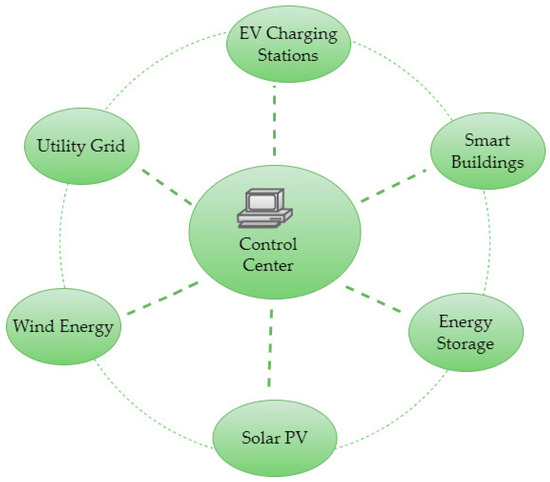
Figure 1.
Smart grid with Renewables, Energy Storage, and EV charging stations.
The potential features of EVs welcome governments to undertake heavy investments in EV adoption. EVs are currently viewed as key pillars for economic development. The current automobile market is highly focused on EVs and Plug-In-EVs (PEVs). A study by Canalys shows that EV sales have boomed up in 2020, and by 2030, EVs will represent almost 50% of total cars, globally, as illustrated in Figure 2 [17].
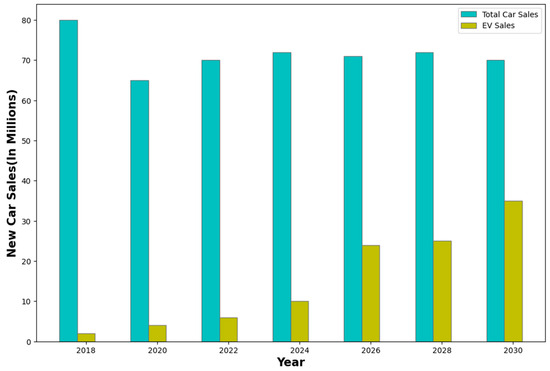
Figure 2.
Projected Sales of EV by 2030 as per Canalys Report [17].
However, even with all the benefits, certain barriers hinder the adoption of EV technology. The major problems slowing the adoption of EVs include range anxiety, inadequate infrastructure for charging, cost of ownership, and a lack of consumer awareness [18,19,20]. In this respect, it is essential to comprehend the shift of interest in the automobile and power markets. This paper discusses the various concepts related to GEVs, the opportunities offered by V2G, the barriers to implementation, and the possible solutions. The work also gives an overview of the state of research in vehicle grid integration.
The paper is structured as follows: Section 2 details the different types of EVs. Section 3 and Section 4 detail the concepts of V2H, V2V, and V2G technologies. In Section 5, various benefits of V2G technology are explored. Section 6 discusses the challenges associated with V2G technology. Section 7 discusses the existing policies. Conclusions are provided in Section 8 and future directions are discussed in Section 9.
2. Categories of EVs
The major categories of EVs are Battery EVs (BEV), Hybrid EVs (HEV), Plug-In Hybrid EVs (PHEV), and Fuel Cell EVs (FCEV).
2.1. BEV
Figure 3 shows the diagram of a BEV. These vehicles also referred to as All-Electric Vehicles (AEV), run entirely on a battery. Connecting to the utility grid, the big battery pack may be charged, which can power single or multiple electric motors. These do not produce any tailpipe emissions caused by conventional ICE vehicles. BMW i3, BMW i4, Chevrolet Bolt EV, Nissan Leaf, etc. are BEVs.
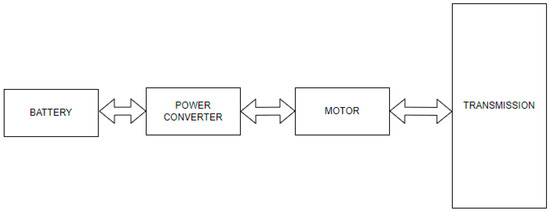
Figure 3.
Battery EV.
2.2. HEV
Here, both the engine and electric motor are present, as given in Figure 4. The battery obtains energy through regenerative braking. The transmission can be rotated by both the engine and an electric motor. Regular HEVs cannot be recharged from the utility grid.
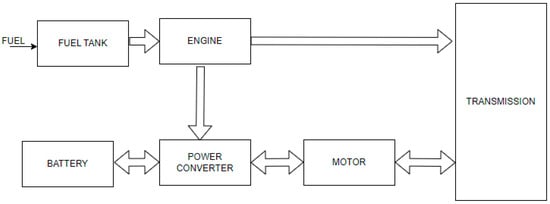
Figure 4.
Hybrid EV.
2.3. PHEV
As shown in Figure 5, PHEVs have an engine as well as a motor, similar to HEVs. However, there are differences. PHEVs generally include a larger battery pack and powerful motors compared with HEVs. The battery packs get recharged automatically by regenerative braking, like HEV. In addition, these can also be plugged into the grid for charging.

Figure 5.
Plug-In Hybrid EV.
2.4. FCEV
These are vehicles with zero emissions, as shown in Figure 6. FCEV is similar to BEV in that they also use electrical energy to drive the vehicle. However, they do not store electrical energy like BEV but instead generate electrical energy using hydrogen, through a chemical reaction. These do not need charging from the utility grid.
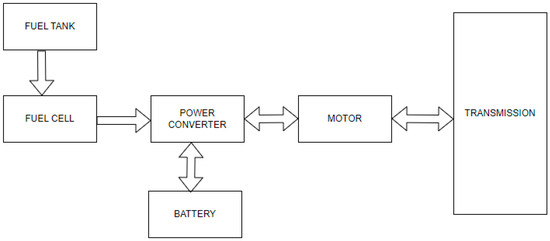
Figure 6.
Fuel Cell EV.
3. EV as a Source and Store of Energy-V2G, V2H, V2V
EVs are not just transportation tools but also resources of energy. EVs with bidirectional chargers can be used to power a home, power another EV, or even feed the utility grid. In V2H operation, as illustrated in Figure 7, EVs are wired to the residence by employing a bidirectional charger. Based on the control strategy, EVs can use energy from the home or supply energy back to the home [21,22]. When a PHEV is combined with a rooftop Solar PV system, this can form a small microgrid and provide sufficient power backup for the home. This supports off-grid operation by supplying the home loads in case of a grid power outage [22].
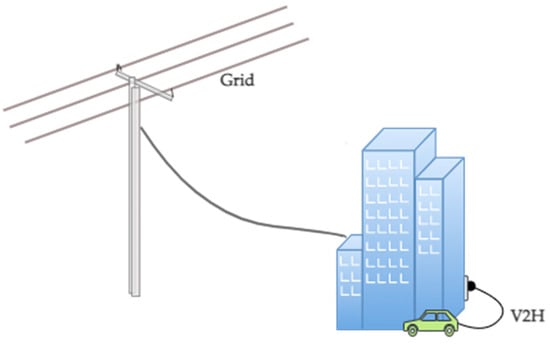
Figure 7.
Power flow: V2H.
V2V operation facilitates charge transfer among EVs, as shown in Figure 8. This concept allows vehicle owners to share their battery charge with other vehicle owners [23,24].
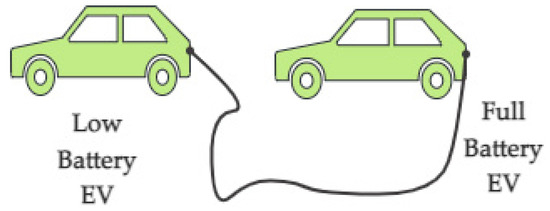
Figure 8.
Power exchange between two vehicles.
In V2G, the GEV can be wired to the utility grid to use energy from the grid or supply energy to the grid, as shown in Figure 9.
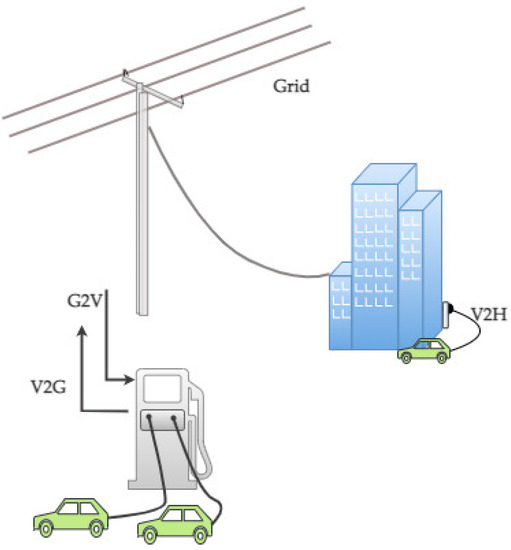
Figure 9.
Bidirectional flow of power involving V2G and V2H.
An aggregator is present as a mediator between the Control Center and EVs. The energy associated with an individual EV is very limited. Hence, the aggregator uses a group of GEVs for operations involving charging and grid regulation [25].
4. Vehicle-to-Grid
V2G is the most prominent and popular V2X technology due to its capacity to supply power to the grid, thereby contributing to the national energy market. When there is surplus power, GEVs will be charged from the utility grid. Furthermore, when the system is in power-deficient operation, GEVs will send electricity back to the grid. This technology enhances the reliability and stability of the power system. Furthermore, it promotes the integration of RES into the utility grid [26,27,28,29,30]. V2G has huge transformative potential for the energy sector. It generates new business models and more revenue opportunities in society [31]. Along with the various benefits, it also brings out new challenges in power system planning and operation.
5. V2G Opportunities
Some of the major literature explaining the benefits of V2G to society is tabulated in Table 1.
- A.
- Renewable Energy Storage
The most prominent role of EVs and V2G technology is to support RES [32,33,34,35,36,37]. The lack of an efficient storage system is a hindrance to the acceptance of renewables in a power grid. RES like solar PV and wind are intermittent in nature. Solar energy follows a daily cycle, and energy output from solar peaks approximately four hours before peak demand. Wind energy is very erratic and location-specific; a site may have less wind for many days, while a cluster of sites spread out over a greater area may be steadier. In a system where RES contributes to more than 30% of the total power, this intermittent nature is a serious concern [32]. In India, as per the Ministry of New and Renewable Energy (MNRE), the expected share of RES will be 40% by 2030. At this level of penetration, distribution companies are facing issues due to the intermittency of RES and the associated need for system flexibility [33]. In this regard, EVs may be used to store renewable energy, and by V2G protocol, feed this energy to the utility grid. In the case of wind turbine generators, the surplus energy generated during windy conditions can be stored in EV batteries and can be provided to the grid during a time of high load, thereby overcoming the problem of intermittency associated with wind energy generation. In a wind energy system including EVs, during heavy wind conditions,
where EEV is the energy associated with the EV, Pwind is the wind power, and Pgrid is the grid power. During light wind conditions,
Considering the associated benefits, the optimized control of an EV-RES integrated system is an area of extensive research. In a case study conducted in Germany [34], the role of PEVs in the grid integration of RES is calculated. With their high power-to-energy ratio, PEVs contribute positively to the integration of RES into the utility; however, it also depends on the characteristics of the RES. The work in [35] proposes a scheme that provides distributed spinning reserves, considering the unplanned intermittency of renewable resources. In [36], a solar-Hydrogen-EV-integrated microgrid utilizing V2G and power-to-gas technology is discussed. A stochastic optimization strategy is devised, aiming to reduce the operational cost. Results show that both technologies combined reduced the operational cost by approximately 27.5%. In [37], a Fuzzy-Logic-Controller (FLC) is proposed for an EV-Wind integrated system that considers the stochastic nature of the RES and the residential loads. The proposed system was able to achieve reduced power losses, an improved voltage profile, and a reliable supply.
- B.
- Peak Shaving and Valley Filling
Another promising role of V2G technology is peak shaving and valley filling. A study in the US shows that the majority of vehicles are stationary for almost 95% of the time [38]. EVs may recharge during off-peak periods, thereby helping to fill the load curve valleys [39]. In some scenarios, the difference between peak demand and the valley can be as high as 50–60% [40,41]. V2G can be viewed as an efficient solution for peak shaving and valley filling. Cost-benefit studies and the feasibility of V2G in different scenarios were part of several studies [42,43,44,45]. A case study of EVs participating in peak shaving is conducted in Shanghai using four brands of EVs—BYD e6, Roewe e50, Nissan Leaf, and Tesla Model S [42]. Cost-benefit studies for EV users as well as power grid companies are carried out separately in this study. The literature in [43] studies the Dynamic Economic/Emission Dispatch (DEED) considering the use of PEVs in peak shaving and valley filling. A multi-objective optimization is formulated that minimizes the total cost as well as the emissions. The metaheuristic BAT algorithm is used to solve the problem. An adaptive charging/discharging scheme for peak shaving is discussed in [44]. In [45], a case study conducted at a parking garage in Dansmästaren, Uppsala, Sweden, is detailed. The work involves a neural network for load prediction, followed by a rule-based peak shaving control strategy. A considerable reduction, almost 38.6%, in peak demand is achieved.
- C.
- Frequency Regulation
EVs operating in V2G mode can also assist in frequency and voltage regulation [46]. The works in [47,48,49,50,51,52] explain the utilization of V2G service in peak reduction and frequency regulation. Peterson et al. [48] suggest that using V2G technology for dual use, i.e., for frequency regulation and peak reduction, is more economically beneficial than single use. The financial aspects of V2G in frequency regulation are detailed in [49]. Various costs, fixed costs, energy costs, and the cost of battery degradation are considered. Liu et al. [50] proposed a frequency regulation technique involving a large number of EVs. The aggregator calculates the regulation requirements based on the expected V2G capability of the EVs and their total Frequency Regulation Capacity (FRC) and dispatch to the vehicles and charging stations. In [51], primary frequency control (PFC) using V2G in an Industrial Micro-Grid (IMG) is examined. The model consists of a Charging Station Operator (CSO), an aggregator, an IMG Operator, and EVs as shown in Figure 10. The framework implemented is shown in Figure 11. CSO dispatches the FRC information to the aggregator, and accordingly, decisions are taken by the aggregator.
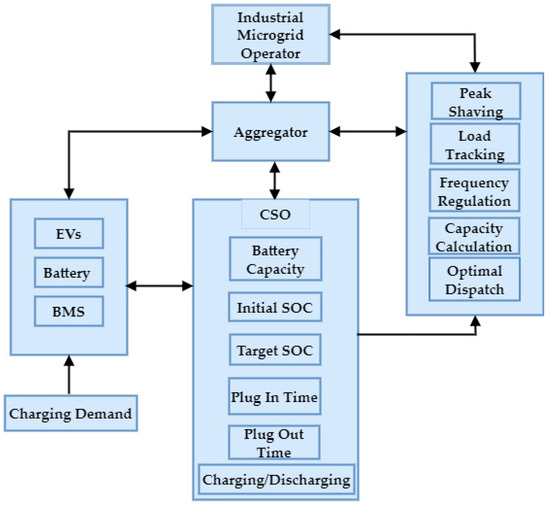
Figure 10.
Conceptual View of PFC model involving microgrid. Operator, aggregator, CSO and EVs [51].
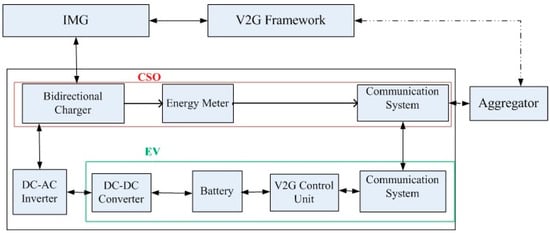
Figure 11.
CSO and V2G framework [51].
- D.
- Benefits for Existing Power Generation Units
The involvement of EVs in providing grid services through V2G can reduce the investments required by the existing power generation units [53]. Any sudden increase in demand can be supplied from the EV battery storage without causing a burden on the generation units. This reduces the need for additional power generation plants, thereby reducing the associated installation, operation, and maintenance costs.
- E.
- Revenue Generation for EV Owners
V2G operations can be economically beneficial to EV owners in multiple ways. EV owners with small-scale solar or wind units at home can optimize their energy consumption. The work in [54] compares the different charging strategies, i.e., unmanaged, smart charging, and bidirectional charging, in a solar-connected German household. The study shows that smart, bidirectional charging of EVs reduces households’ electricity costs. In a different aspect, all over the globe, governments are framing policies involving incentives for EV owners taking part in V2G operations. The provision of ancillary services is attractive to EV owners as well as aggregators. The economic benefits of EV owners participating in ancillary services are analyzed in [55]. Based on the EV data taken from Shanghai and Chengdu, an optimization framework is developed with the objective of bringing financial benefit to the EV owners. The study highlights the significant savings for EV owners by participating in the V2G market.

Table 1.
Literatures on the benefits of V2G.
Table 1.
Literatures on the benefits of V2G.
| Aspects | Literature | Area of Study | Remarks |
|---|---|---|---|
| Environmental | [34,35] | PEV contributing to RES integration | Role of PEVs in integrating intermittent RES in the utility is discussed. |
| [35] | VGI impact on RES Integration | Performs a quantitative analysis of VGI aspects. V2G power required for stabilization of RES like solar and wind are calculated. | |
| [36] | V2G in a solar- hydrogen microgrid | Studies the effect of V2G technology in a solar-hydrogen microgrid. Results on real world data prove that daily operating costs can be reduced by up to 27.5%. | |
| [37] | EV-Wind-Energy Storage Integrated System | Fuzzy Logic Control employed to achieve the energy management between wind, EV, storage system and the utility. | |
| Technical | [15,43] | Peak Shaving and Valley Filling | Considering various EV power, battery pack SOC and user constraints, V2G optimization strategies are suggested. |
| [49] | Frequency Regulation | Quantitatively analyses the financial aspects of V2G in frequency regulation. | |
| [50,52] | Frequency Regulation | Aggregator based control strategies for V2G based regulation is presented. | |
| Financial | [53] | Savings on new generation units | Studies the impact of V2G in reducing operation costs and need for new generation units. |
| [54] | Savings by optimized charging. | Optimized energy consumption in a Solar incorporated household. | |
| [55] | Benefits from Ancillary Services | An optimization framework to maximize the economic benefits from selling ancillary services. |
6. V2G Challenges
Even with all the benefits, some barriers hinder the adoption of EVs and V2X services. Lack of charging infrastructure, range anxiety, ownership cost, and lack of consumer awareness about EVs are some of the factors delaying the adoption of EVs. Moreover, for the successful implementation of EV and V2G services, some areas need extensive focus and research. Table 2 lists some of the major literature in this regard.
- A.
- Battery Degradation
In order to participate in V2G, the battery has to undergo many charging-discharging cycles. The impact on battery health due to V2G operation has been studied in a lot of papers but with a lot of contradictory results. Dubarry et al., in [56], aim to understand the effect of bidirectional charging on the performance of lithium-ion batteries. Experimental results show that discharging an EV battery to the grid can negatively affect battery life and performance. The study in [57] presents a lithium-ion battery aging model validated using real-world data. Furthermore, an algorithm using V2G is developed to minimize battery degradation. In contrast with the previous work, the proposed V2G-based algorithm is found to increase battery life. The authors reconciled their findings in another work [58] and discussed better battery management in EVs. All these studies demand further research in this direction.
- B.
- Power Electronics—Charging Infrastructure
Power Electronics has a significant role in the grid integration of EVs. VGI is completely based on bidirectional power flow. The bidirectional interface between the EV and the grid charges the EV battery with the required capacity and also feeds the power back to the utility, following all power regulations and standards.
This bidirectional unit can be made using two unidirectional converters or with a single bidirectional converter, as illustrated in Figure 12 and Figure 13 [59]. Unidirectional converters result in more cost and weight concerns; hence, in V2G systems, bidirectional converters are now preferred. In [60], the author explains high-voltage-800V DC link voltage systems, which are in development, for EVs. Compared with 400V systems, these offer savings in charging time, a reduction in weight, and increased efficiency. Higher initial development costs are a disadvantage; however, over the long term, this can be reduced. J. Wang et al., in [61], review several isolated and non-isolated BDC topologies for EV. The need for a reliable BDC with an improved voltage conversion ratio for high-voltage EV systems is also discussed.
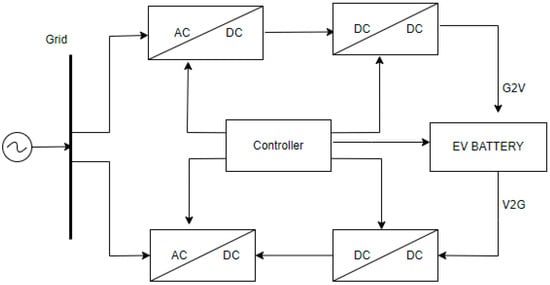
Figure 12.
G2V and V2G using two unidirectional converters.
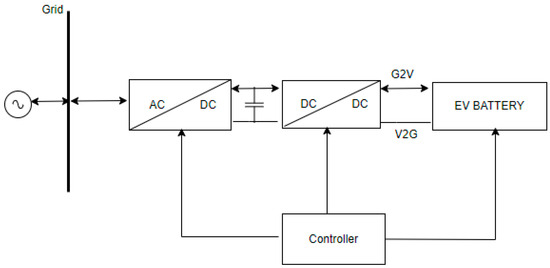
Figure 13.
G2V and V2G using two bidirectional converters.
Research aiming to increase bus voltage levels demands the use of BDCs with better voltage conversion efficiency and output voltage stability. Nonlinear modeling and control of BDC is also an area of further research. Research on power electronic infrastructure acquired great momentum with the emergence of wide-band gap devices like GaN and SiC. These devices provide high switching frequencies and reduced loss, reduce the volume of storage elements, and improve the power density. However, high switching frequencies cause considerably high Electro Magnetic Interference (EMI). The work in [62] experimentally analyzes the dynamic characteristics of GaN and SiC devices and concludes that fast switching has an impact on EMI in the megahertz range. Designing an optimal switching frequency while keeping the balance between power density and EMI is another area of research needed in the direction of wide-band gap converters.
- C.
- Impacts on Grid Power Quality
The charging of EVs influences the power quality of the distribution grid. The impacts on various parts of the distribution grid are discussed in [63,64,65,66,67,68,69]. Non-coordinated charging of EVs gives rise to unplanned, undesired peaks in the grid demand. Also, the presence of non-linear components in the charging infrastructure and fast charging introduce harmonic content in the grid voltage. This also leads to voltage instability, power loss, transformer over-loading, and degradation of reliability indices. Furthermore, in places where EVs are charged from already existing connections, this causes voltage instability in the host establishments [70,71,72].
Proper scheduling, clustering, and forecasting measures can reduce these impacts to a great extent [73]. Charge scheduling for EVs is an optimization problem that takes in EVs, grid, aggregator parameters, and user parameters and provides a charging schedule for all EVs considered. Depending on the constraints, this problem aims to optimize either one or multiple parameters related to aggregator-side, grid-side, or users [74]. This gives rise to multiple different optimization problems and, hence, is a subject of extensive research [75,76,77,78,79,80,81]. Table 3 lists some of the major literature in this regard. The works of literature in [75,76,77] aim to minimize the total cost incurred by the users. A centralized scheduling technique to minimize the total cost and user discomfort is detailed in [75]. The literature in [76] aims to minimize the total cost by formulating a global optimization problem and a local optimization problem. The local optimization gives a practical, scalable solution for handling the dynamics of EV arrivals. In [78], the optimization objective is to maximize the parking lot revenue and maximize the number of vehicles getting fully recharged. This work takes into account the mobility aspects of EVs; however, V2G mode of operation is not considered. In [79], the objective is to maximize aggregator revenues by optimizing ancillary services. The work in [81] approaches scheduling from the viewpoint of an EV-hailing company and provides a solution as a vector of hierarchical mixed variables. The function to be minimized consists of time cost, charging expense, and the difference between the final SoC of an EV and its expected SoC. Time cost is the sum of driving time, waiting time, and charging time. The charging expense includes the expenses for charging at all stations.
Clustering charging data helps in identifying trends and patterns in charging. By clustering the data over specific time periods—year, month, or week—EV demand patterns can be studied [82,83]. Furthermore, accurate and efficient EV demand forecasting systems, for short-term, medium-term, and long-term, can help in critical decision-making and utility developments [84,85,86,87,88,89,90]. Several mathematical, statistical, and data-driven AI-based methods are employed for EV demand forecasting. EV load forecasting using AI, especially deep learning techniques, has gained significant momentum recently. The metrics commonly used for evaluation are mean-absolute-error (MAE), root-mean-square-error (RMSE), coefficient of determination (R2), and mean-absolute-percentage-error (MAPE).
MAE: MAE is the mean value of the absolute difference between expected and predicted values.
RMSE: RMSE is the square root of the mean value of the squared difference between expected and predicted values. RMSE gives more weight to larger errors and is used when larger errors are not desirable in the system. This can be equal to or greater than MAE.
R2: This metric indicates the variance in the predicted variable. R2 will always be less than 1. A higher value is preferred for this metric.
MAPE: MAPE is a normalized metric and hence suitable for comparison across works.
A smaller value is preferred for MAE, RMSE, and MAPE, while a higher value is desirable for R2. A performance comparison of some of the recent literature in this area is listed in Table 4.
Several load management and demand response strategies at the distribution level are studied in [91,92,93]. A centralized scheme with Mixed Integer Linear Programming is proposed in [91]. Literature [92] discusses two load management strategies: loss-optimal and cost-optimal. The former aims at charging the vehicles with minimum losses, while the latter aims at charging at the lowest cost possible. The work in [93] proposes a decentralized strategy that restrains load demand during contingencies by optimizing the demand rebound index and customer convenience indices.

Table 2.
Literature on various challenges and barriers of V2G.
Table 2.
Literature on various challenges and barriers of V2G.
| Aspects | Literatures | Area of Study | Remarks |
|---|---|---|---|
| Technical | [56,57,58] | Battery Degradation | Studies the effect of bidirectional power flow on the lifecycle of batteries. |
| [59,60,61,62] | Charging Infrastructure | Various Bidirectional topologies and associated Power Electronics challenges | |
| [63,64,65,66,67,68,69,70,71] | Grid Power Quality | VGI has a huge impact on the power quality. Issues like voltage instability, harmonics and undesired peaks due to non-coordinated charging are discussed. | |
| [94,95,96,97,98,99,100,101,102] | Communication Requirements | Discusses secure protocols for V2G communication. | |
| Environment | [103,104,105,106,107,108,109,110,111,112] | Impacts on environment | Environmental Concerns including extraction of rare earth minerals |
| Financial | [113] | Initial Cost | Grid Integration capabilities can cause an increase in the initial cost of EVs. |
| Socio-Cultural | [39,114] | Market Availability | Availability of GEVs is a concern discussed. |
| [115,116,117] | Consumer Interests | Studies the approaches of EV owners towards grid integration of their vehicles. |

Table 3.
Various Optimizations in Charge Scheduling.
Table 3.
Various Optimizations in Charge Scheduling.
| Literatures | Optimization Objective | Merits | Remarks |
|---|---|---|---|
| [75] | Minimize total cost and user discomfort | Cost-savings, flexibility in setting the trade-off between cost and user comfort, peak demand reduction | Centralized Scheduling Technique. Assumes there are no losses in the transmission between EV and residential system. |
| [76] | Minimize total cost | Both global and local optimal solutions computed. Local optimal solution gives a very practical and satisfying performance | Distributed Scheduling |
| [77] | Minimize total electricity cost of users as well as utility companies | Flattened demand response, reduced bills. Considers renewable generations also | Distributed Scheduling |
| [78] | Maximize parking lot revenue & Maximize the number of fully recharged EVs | Considers the mobility aspects of EVs. | Does not consider V2G aspects and Distributed Generation |
| [79] | Maximize Aggregator Revenue by optimizing Ancillary Services | Significant profits for aggregator, reduction in consumer cost and peak load reduction | Considerable battery degradation cost |
| [80] | Minimize total daily price incurred by CSO | Considers both V2G and G2V operations at an interval of at least 30 min | - |
| [81] | Minimize Average time cost, Minimize Average Charging Expense, Minimize the difference between final and expected SoC | Less run time cost | Charging scheduling carried out from the viewpoint of an EV-hailing company |

Table 4.
Some of the recent literatures on AI based EV Load Forecasting.
Table 4.
Some of the recent literatures on AI based EV Load Forecasting.
| Literatures | AI Technique Employed | Performance Metric | Results |
|---|---|---|---|
| [86] | Support Vector | MAPE, RMSE | Charging Load in kW is forecasted. MAPE: 3.69%, RMSE: 50.13 kW |
| [87] | Linear Regression, SVM, Random Forest, XGBoost | R2, RMSE | Charging Demand in kWh is predicted. XGBoost performs better with R2: 0.519, RMSE: 6.68 kWh |
| [88] | Multivariate LSTM | MAE, RMSE | Charging Power in kW is predicted. LSTM with calendar and weather features has the leading performance with MAE of 0.89 kW and RMSE of 1.92 kW |
| [89] | Multiple Linear Regression, Quantile Regression, SVM, LSTM, LSTM-Bayesian Deep Learning (LSTM-BDL) | RMSE, MAE, R2 | Charging Load in kWh is forecasted. LSTM-BDL with MAE: 2.78 kWh, RMSE: 4.367 kWh and R2: 0.918 outperforms the other models. |
| [90] | Transformer model | RMSE | Charging demand in kW is predicted. RMSE: 0.085 kW, 0.096 kW, and 0.112 kW for forecasting demand ahead of 30 days, 60 days and 90 days, respectively |
- D.
- Communication
Successful implementation of V2G demands a reliable real-time communication system. A lot of communication is involved between aggregators, control centers, and vehicles. The Control Center communicates charging rate, power commands, time, etc. to the aggregator. The aggregator sends charging details, charging station details, charger details, power commands, etc. to the EVs. Furthermore, the aggregator informs the Control Center about the EVs at the station, station location, charging time details, power level, etc. Considering the huge volume of data transmission, the mobility of EVs, and the need for fast response, V2G communication demands fast authentication and encryption/decryption. Furthermore, the communication requirements differ for EV fleets and dispersed EVs. For a group of EVs in a parking lot, the communication protocol could be simple. Each parking lot could have its own telecommunication devices. A more extensive and distant communications link would be required for dispersed V2G sources. Several works have been carried out in this regard [94,95,96,97,98,99,100,101,102]. Dedicated short range communication (DSRC) and cellular networks are the major V2X communication technologies. DSRC has the advantages of low latency, high reliability, security, and interoperability [96]. Cellular long-term evolution (LTE) also has the benefit of low latency, a large area of coverage, and a high data rate [97,98]. The study in [99,100,101] compares the performances of DSRC and cellular LTE technologies for V2X. DSRC is preferred over 4G-LTE for safety applications. For applications where safety is not a major concern, 4G-LTE is preferred over DSRC [99]. In [100], the authors highlight the limitations of both technologies and suggest interworking both for efficient V2X applications.
- E.
- Environmental Concerns
Although the adoption of EVs and V2G technology offers a lot of environmental benefits, they are not free of environmental concerns [103]. The BEV manufacturing process produces considerable pollution to the environment. This also includes the extraction and refining of rare earth minerals, which have a significant impact on the environment [104,105,106]. With the advancement of EV and V2X technologies, the demand for lithium (Li) batteries is increasing. The process of Li extraction and separation involves a lot of chemical procedures and poses a severe danger to the environment [107]. Careless disposal of these batteries can cause toxic materials to reach the ground and can also lead to fire hazards. The manufacturing process and the chemicals involved in it can lead to health hazards. Hence, it is essential to have a well-defined, environment-friendly end-of-life (EOL) strategy for the batteries [108,109]. The work in [110] analyzes the EOL regulatory policies of Li-ion batteries in the United States. Also, a set of actionable recommendations is provided. The work in [111] states that V2G can reduce carbon emissions only by following an optimized charging schedule. On the other hand, V2G will increase carbon dioxide emissions if off-peak generated energy is used for peak load reduction. It is clear that the V2G transition promotes the consumption of electricity. Currently, electricity production is mainly dominated by power plants, which require a large amount of water for steam production and cooling. Hence, the adoption of these technologies may be difficult in water-scarce regions [112].
- F.
- Initial Cost
With the modified charging structure and the potential benefits, EVs with grid integration capabilities can be more expensive compared to conventional vehicles. Even though future revenue generation by V2G is a monetary benefit, consumer awareness in this regard is very important [113].
- G.
- Availability and Suitability of EVs
The suitability of EVs for grid integration is a factor delaying the adoption of large-scale vehicle-grid integration. At present, only a few EV models are V2G-capable. 2013 Nissan LEAF Model (and newer models), Mitsubishi iMieV, Nissan e-VN200, Mitsubishi Outlander PHEV etc. are some of the models with V2G capability [39,114]. For the nationwide adoption of V2G to be successful, more EVs with V2G capability should be brought to the market.
- H.
- Non-cooperation from EV owners
EV-owner-based research reveals that there are various other potential barriers to V2G implementation. Consumer distrust in the utility or any agency implementing the grid integration program is one among them. Research among PEV buyers in Canada shows that EV owners in the country have concerns about trust, privacy, and loss of control [114,115]. Some consumers in the country face difficulty understanding concepts like ‘improving the efficiency of grid’ or ‘reducing environmental impact’. Concerns about battery degradation are another factor in non-cooperation. The works in [116,117] show similar studies carried out in different parts of the globe. Based on the studies, V2G adoption can be accelerated by creating proper awareness among EV owners and by providing sufficient monetary benefits.
The grid integration of EVs has a lot of benefits to offer society. However, the aforementioned challenges also need to be resolved. The feasibility of V2G in a developing economy like India has been an area of many studies [118]. The successful implementation of V2G technology needs further research and development of the market and infrastructure.
7. Current Policies
The International Energy Agency (IEA) lists the key policies regarding the deployment of EVs in [119]. IEA’s policy manual on global V2G policies explains the various existing policies, along with the recommendations, for ensuring a smooth transition to e-mobility and grid integration [120]. The report lists the motivations and concerns of different operational and planning stakeholders involved in grid integration. Measures to increase V2G adoption, which include special tariff structures for co-location of EVs and renewables and many more, are also mentioned. Incentives and regulations are implemented all over the globe to promote the adoption of EVs and smart charging.
For example, in Luxembourg, incentives are given to open charge point protocol (OCPP)-compliant smart charging stations. In Belgium, tax deductions are provided for publicly accessible charging points and incentives for residential charging points. Incentives for charging infrastructure development linked to renewables have been implemented in many nations. In Belgium, tax incentives for home charging are provided if the user shows that the charging point is supplied by an RES. In Germany, between 2018 and 2021, grants were given for the development of RES-supplied charging points. In India, under the scheme of faster adoption and manufacturing of hybrid and electric vehicles (FAME), incentives and grants are given for the adoption of EV technology [121,122].
8. Conclusions
The work reviewed various aspects of V2G technology, including its benefits and challenges. Studies show that the automobile and electric power industries are complementary to each other, and supporting one with the other is beneficial to both. V2G technology holds a lot of promise in terms of green energy, low emissions, energy efficiency, and power system reliability. This technology allows easy integration of renewable resources into the utility and also provides ancillary services. With a good volume of EVs with V2G capability on the roads and an efficient power management and control strategy, the power sector can be made more reliable and stable. However, successful grid integration of EVs has a lot of barriers, especially in a developing economy. Availability of GEVs, battery life and efficiency, charging infrastructure, communication infrastructure, worries of EV owners, high cost, etc. are the major factors affecting the implementation of V2G.
A good amount of research and related work is required to implement and fully utilize the benefits of V2G. Implementation of a sufficient number of pilot projects is also required to understand the impacts and feasibility of V2G technology in the country. With the joint support of EV manufacturers, EV owners, governments, and other policymakers, the adoption and implementation of vehicle-grid integration can be accelerated to meet the goals of green energy, a clean environment, and better power stability.
9. Future Directions
The future of V2X technology is promising. All the major automobile manufacturers are serious and focused on developing bidirectional charging capacity. The latest communication technologies are being brought in and integrated to better facilitate V2X services. This will also aid in better autonomous driving systems. In the scenario of the global energy crisis and global warming, EVs and V2G technology have a lot to offer. Renewable-based EV charging is gaining momentum. Efforts in the direction of renewable-based charging and microgrids with V2X capability can lead to sustainable transportation and an energy-efficient future.
Author Contributions
Ideation, G.V., D.K. and R.J.; Writing & editing—original draft, G.V.; Review & editing, G.V., D.K., R.J. and A.K.; project administration, V.K.C. and A.G. All authors have read and agreed to the published version of the manuscript.
Funding
This research received no external funding.
Institutional Review Board Statement
Not applicable.
Informed Consent Statement
Not applicable.
Data Availability Statement
No new data were created or analyzed in this study. Data sharing is not applicable to this article.
Conflicts of Interest
The authors declare no conflict of interest.
References
- Olawebcdn. Available online: https://olawebcdn.com/ola-institute/OMI_White_Paper_Vehicle_to_Grid_(V2G)_in_India.pdf (accessed on 22 October 2022).
- Zolfagharinia, H.; Zangiabadi, M.; Hafezi, M. How much is enough? Government subsidies in supporting green product development. Eur. J. Oper. Res. 2023, 309, 1316–1333. [Google Scholar] [CrossRef]
- Song, S.; Lin, H.; Sherman, P.; Yang, X.; Chen, S.; Lu, X.; Lu, T.; Chen, X.; McElroy, M.B. Deep Decarbonization of the Indian Economy: 2050 Prospects for Wind, Solar, and Green Hydrogen. iScience 2022, 25, 104399. [Google Scholar] [CrossRef] [PubMed]
- Bistline, J.E.T.; Young, D.T. The Role of Natural Gas in Reaching Net-Zero Emissions in the Electric Sector. Nat. Commun. 2022, 13, 4743. [Google Scholar] [CrossRef] [PubMed]
- Shukla, P.R.; Skea, J.; Slade, R.; Al Khourdajie, A.; van Diemen, R.; McCollum, D.; Pathak, M.; Some, S.; Vyas, P.; Fradera, R.; et al. (Eds.) IPCC, 2022: Climate Change 2022: Mitigation of Climate Change: Contribution of Working Group III to the Sixth Assessment Report of the Intergovernmental Panel on Climate Change; Cambridge University Press: Cambridge, UK; New York, NY, USA, 2022. [Google Scholar] [CrossRef]
- Colmenar-Santos, A.; Muñoz-Gómez, A.-M.; Rosales-Asensio, E.; López-Rey, Á. Electric vehicle charging strategy to support renewable energy sources in Europe 2050 low-carbon scenario. Energy 2019, 183, 61–74. [Google Scholar] [CrossRef]
- Klingler, A.-L. The effect of electric vehicles and heat pumps on the market potential of PV + battery systems. Energy 2018, 161, 1064–1073. [Google Scholar] [CrossRef]
- Szinai, J.K.; Sheppard, C.J.; Abhyankar, N.; Gopal, A.R. Reduced grid operating costs and renewable energy curtailment with electric vehicle charge management. Energy Policy 2020, 136, 111051. [Google Scholar] [CrossRef]
- Eldho, R.P.; Deepa, K. A comprehensive overview on the current trends and technological challenges in energy storages and charging mechanism in electric vehicle. J. Green Eng. 2020, 10, 4679–6713. [Google Scholar]
- Poornesh, K.; Nivya, K.P.; Sireesha, K. A Comparative study on Electric Vehicle and Internal Combustion Engine Vehicles. In Proceedings of the 2020 International Conference on Smart Electronics and Communication (ICOSEC), Trichy, India, 10–12 September 2020. [Google Scholar]
- Chan, C.C. The state of the art of electric and hybrid vehicles. Proc. IEEE 2002, 90, 247–275. [Google Scholar] [CrossRef]
- Chan, C.C.; Chau, K.T.; Jiang, J.Z.; Xia, W.; Zhu, M.; Zhang, R. Novel permanent magnet motor drives for electric vehicles. IEEE Trans. Ind. Electron. 1996, 43, 331–339. [Google Scholar] [CrossRef]
- Bose, B.K.; Szczesny, P.M. A microcomputer-based control and simulation of an advanced IPM synchronous machine drive system for electric vehicle propulsion. IEEE Trans. Ind. Electron. 1988, 35, 547–559. [Google Scholar] [CrossRef]
- Pearre, N.S.; Ribberink, H. Review of research on V2X technologies, strategies, and operations. Renew. Sustain. Energy Rev. 2019, 105, 61–70. [Google Scholar] [CrossRef]
- Corchero, C.; Sanmarti, M. Vehicle-to-Everything (V2X): Benefits and Barriers. In Proceedings of the 2018 15th International Conference on the European Energy Market (EEM), Lodz, Poland, 27–29 June 2018; pp. 1–4. [Google Scholar] [CrossRef]
- Khezri, R.; Steen, D.; Tuan, L.A. A Review on Implementation of Vehicle to Everything (V2X): Benefits, Barriers and Measures. In Proceedings of the 2022 IEEE PES Innovative Smart Grid Technologies Conference Europe (ISGT-Europe), Novi Sad, Serbia, 10–12 October 2022; pp. 1–6. [Google Scholar]
- Global Electric Vehicle Market 2020 and Forecasts Canalys Newsroom. Available online: https://canalys.com/newsroom/canalys-global-electric-vehicle-sales-2020 (accessed on 13 February 2023).
- Biresselioglu, M.E.; Demirbag Kaplan, M.; Yilmaz, B.K. Electric Mobility in Europe: A Comprehensive Review of Motivators and Barriers in Decision Making Processes. Transp. Res. Part A Policy Pract. 2018, 109, 1–13. [Google Scholar] [CrossRef]
- Berkeley, N.; Jarvis, D.; Jones, A. Analysing the Take up of Battery Electric Vehicles: An Investigation of Barriers amongst Drivers in the UK. Transp. Res. Part D Transp. Environ. 2018, 63, 466–481. [Google Scholar] [CrossRef]
- Powell, S.; Cezar, G.V.; Min, L.; Azevedo, I.M.L.; Rajagopal, R. Charging infrastructure access and operation to reduce the grid impacts of deep electric vehicle adoption. Nat. Energy 2022, 7, 932–945. [Google Scholar] [CrossRef]
- Shemami, M.S.; Amrr, S.M.; Alam, M.S.; Asghar, M.S.J. Reliable and Economy Modes of Operation for Electric Vehicle-to-Home (V2H) System. In Proceedings of the 2018 5th IEEE Uttar Pradesh Section International Conference on Electrical, Electronics and Computer Engineering (UPCON), Gorakhpur, India, 2–4 November 2018; pp. 1–6. [Google Scholar] [CrossRef]
- Shin, H.; Baldick, R. Plug-In Electric Vehicle to Home (V2H) Operation Under a Grid Outage. IEEE Trans. Smart Grid 2017, 8, 2032–2041. [Google Scholar] [CrossRef]
- Datta, U.; Kalam, A.; Shi, J. The Strategies of EV Charge/Discharge Management in Smart Grid Vehicle-to-Everything (V2X) Communication Networks; IntechOpen eBooks: London, UK, 2019. [Google Scholar]
- Vempalli, S.K.; Deepa, K. Novel V2V Charging Method Addressing the Last Mile Connectivity. In Proceedings of the IEEE International Conference on Power Electronics, Drives and Energy Systems, Chennai, India, 18–21 December 2018. [Google Scholar]
- Han, S.; Han, S.; Sezaki, K. Development of an Optimal Vehicle-to-Grid Aggregator for Frequency Regulation. IEEE Trans. Smart Grid 2010, 1, 65–72. [Google Scholar]
- Ala, G.; Di Filippo, G.; Viola, F.; Giglia, G.; Imburgia, A.; Romano, P.; Castiglia, V.; Pellitteri, F.; Schettino, G.; Miceli, R. Different Scenarios of Electric Mobility: Current Situation and Possible Future Developments of Fuel Cell Vehicles in Italy. Sustainability 2020, 12, 564. [Google Scholar] [CrossRef]
- Sassi, H.B.; Errahimi, F.; Essbai, N.; Alaoui, C. V2G and Wireless V2G concepts: State of the Art and Current Challenges. In Proceedings of the 2019 International Conference on Wireless Technologies, Embedded and Intelligent Systems (WITS), Fez, Morocco, 3–4 April 2019; pp. 1–5. [Google Scholar] [CrossRef]
- Ali, H.; Hussain, S.; Khan, H.A.; Arshad, N.; Khan, I.A. Economic and Environmental Impact of Vehicle-to-Grid (V2G) Integration in an Intermittent Utility Grid. In Proceedings of the 2020 2nd International Conference on Smart Power & Internet Energy Systems (SPIES), Bangkok, Thailand, 15–18 September 2020; pp. 345–349. [Google Scholar] [CrossRef]
- Vineel Kumar, K.; Deepa, K. V2G/G2V Bi-Directional On-Board EV Charger Using Two Phase Interleaved DC-DC Converter. In Modeling, Simulation and Optimization; Springer: Berlin/Heidelberg, Germany, 2022; pp. 49–61. [Google Scholar] [CrossRef]
- Karthick, A.; Mohanavel, V.; Chinnaiyan, V.K.; Karpagam, J.; Baranilingesan, I.; Rajkumar, S. State of charge prediction of battery management system for electric vehicles. In Active Electrical Distribution Network; Academic Press: Cambridge, MA, USA, 2022; pp. 163–180. [Google Scholar]
- Ahmadian, A.; Sedghi, M.; Mohammadi-ivatloo, B.; Elkamel, A.; Golkar, M.A.; Fowler, M. Cost-Benefit Analysis of V2G Implementation in Distribution Networks Considering PEVs Battery Degradation. IEEE Trans. Sustain. Energy 2018, 9, 961–970. [Google Scholar] [CrossRef]
- Kelly, H.; Weinberg, C.J. Utility strategies for using renewables. In Renewable Energy: Sources for Fuels and Electricity; Johansson, T.B., Kelly, H., Burnham, L., Reddy, A.K.N., Williams, R., Eds.; Island Press: Washington, DC, USA, 1993. [Google Scholar]
- Vehicle-to-Grid (V2G). Available online: https://www.ceew.in/cef/masterclass/explains/vehicle-to-grid (accessed on 13 February 2023).
- Bharathwaaj, R.; Mohanavel, V.; Karthick, A.; Vasanthaseelan, S.; Ravichandran, M.; Sakthi, T.; Rajkumar, S. Modeling of permanent magnet synchronous motor for zero-emission vehicles. In Active Electrical Distribution Network; Academic Press: Cambridge, MA, USA, 2022; pp. 121–144. [Google Scholar]
- Ota, Y.; Taniguchi, H.; Nakajima, T.; Liyanage, K.M.; Baba, J.; Yokoyama, A. Autonomous Distributed V2G (Vehicle-To-Grid) Satisfying Scheduled Charging. IEEE Trans. Smart Grid 2012, 3, 559–564. [Google Scholar] [CrossRef]
- Hou, L.; Dong, J.; Herrera, O.E.; Mérida, W. Energy Management for Solar-Hydrogen Microgrids with Vehicle-To-Grid and Power-To-Gas Transactions. Int. J. Hydrogen Energy 2023, 48, 2013–2029. [Google Scholar] [CrossRef]
- Khorramdel, H.; Gitizadeh, M.; Chung, C.Y.; Othman, M.M.; Alhelou, H.H. An Adjustable Robust Economic Energy and Reserve Dispatch Problem Incorporating Large-Scale Wind Farms. IEEE Access 2022, 10, 73969–73987. [Google Scholar] [CrossRef]
- Kempton, W.; Letendre, S.E. Electric Vehicles as a New Power Source for Electric Utilities. Transp. Res. Part D Transp. Environ. 1997, 2, 157–175. [Google Scholar] [CrossRef]
- Das, S.; Deb, S. Vehicle-Grid Integration—A New Frontier for Electric Mobility in India. Alliance for an Energy Efficient Economy. Available online: https://aeee.in/wp-content/uploads/2020/10/Full-Report-Vehicle-Grid-Integration-AEEE.pdf (accessed on 30 October 2022).
- Bai, X.; Clark, K.; Jordan, G.A.; Miller, N.W.; Piwko, R.J. Intermittency Analysis Project: Appendix B Impact of Intermittent Generation on Operation of California Power Grid; California Energy Commission: Sacramento, CA, USA, 2007. [Google Scholar]
- IEA. Prospects for Large-Scale Energy Storage in Decarbonised Power Grids; IEA: Paris, France, 2009; Available online: https://www.iea.org/reports/prospects-for-large-scale-energy-storage-in-decarbonised-power-grids (accessed on 20 August 2023).
- Li, X.; Tan, Y.; Liu, X.; Liao, Q.; Sun, B.; Cao, G.; Li, C.; Yang, X.; Wang, Z. A Cost-Benefit Analysis of V2G Electric Vehicles Supporting Peak Shaving in Shanghai. Electr. Power Syst. Res. 2020, 179, 106058. [Google Scholar] [CrossRef]
- Ghosh, A. Possibilities and challenges for the inclusion of the electric vehicle (EV) to reduce the carbon footprint in the transport sector: A review. Energies 2020, 13, 2602. [Google Scholar] [CrossRef]
- Koubaa, R.; Yoldas, Y.; Goren, S.; Krichen, L.; Onen, A. Implementation of Cost Benefit Analysis of Vehicle to Grid Coupled Real Micro-Grid by Considering Battery Energy Wear: Practical Study Case. Energy Environ. 2020, 32, 1292–1314. [Google Scholar] [CrossRef]
- Chandran, V.; Patil, C.K.; Karthick, A.; Ganeshaperumal, D.; Rahim, R.; Ghosh, A. State of charge estimation of lithium-ion battery for electric vehicles using machine learning algorithms. World Electr. Veh. J. 2021, 12, 38. [Google Scholar] [CrossRef]
- Clement-Nyns, K.; Haesen, E.; Driesen, J. The Impact of Vehicle-To-Grid on the Distribution Grid. Electr. Power Syst. Res. 2011, 81, 185–192. [Google Scholar] [CrossRef]
- Tomić, J.; Kempton, W. Using Fleets of Electric-Drive Vehicles for Grid Support. J. Power Sources 2007, 168, 459–468. [Google Scholar] [CrossRef]
- Peterson, S.B.; Whitacre, J.F.; Apt, J. The Economics of Using Plug-in Hybrid Electric Vehicle Battery Packs for Grid Storage. J. Power Sources 2010, 195, 2377–2384. [Google Scholar] [CrossRef]
- White, C.D.; Zhang, K.M. Using Vehicle-To-Grid Technology for Frequency Regulation and Peak-Load Reduction. J. Power Sources 2011, 196, 3972–3980. [Google Scholar] [CrossRef]
- Liu, H.; Hu, Z.; Song, Y.; Wang, J.; Xie, X. Vehicle-to-Grid Control for Supplementary Frequency Regulation Considering Charging Demands. IEEE Trans. Power Syst. 2015, 30, 3110–3119. [Google Scholar] [CrossRef]
- Iqbal, S.; Xin, A.; Jan, M.U.; Salman, S.; Zaki, A.U.M.; Rehman, H.U.; Shinwari, M.F.; Abdelbaky, M.A. V2G Strategy for Primary Frequency Control of an Industrial Microgrid Considering the Charging Station Operator. Electronics 2020, 9, 549. [Google Scholar] [CrossRef]
- Liang, H.; Liu, Y.; Li, F.; Shen, Y. Dynamic Economic/Emission Dispatch Including PEVs for Peak Shaving and Valley Filling. IEEE Trans. Ind. Electron. 2019, 66, 2880–2890. [Google Scholar] [CrossRef]
- Weis, A.; Jaramillo, P.; Michalek, J. Estimating the Potential of Controlled Plug-in Hybrid Electric Vehicle Charging to Reduce Operational and Capacity Expansion Costs for Electric Power Systems with High Wind Penetration. Appl. Energy 2014, 115, 190–204. [Google Scholar] [CrossRef]
- Kern, T.; Dossow, P.; Morlock, E. Revenue Opportunities by Integrating Combined Vehicle-To-Home and Vehicle-To-Grid Applications in Smart Homes. Appl. Energy 2022, 307, 118187. [Google Scholar] [CrossRef]
- Zhou, C.; Xiang, Y.; Huang, Y.; Wei, X.; Liu, Y.; Liu, J. Economic Analysis of Auxiliary Service by V2G: City Comparison Cases. Energy Rep. 2020, 6, 509–514. [Google Scholar] [CrossRef]
- Dubarry, M.; Devie, A.; McKenzie, K. Durability and Reliability of Electric Vehicle Batteries under Electric Utility Grid Operations: Bidirectional Charging Impact Analysis. J. Power Sources 2017, 358, 39–49. [Google Scholar] [CrossRef]
- Uddin, K.; Jackson, T.; Widanage, W.D.; Chouchelamane, G.; Jennings, P.A.; Marco, J. On the Possibility of Extending the Lifetime of Lithium-Ion Batteries through Optimal V2G Facilitated by an Integrated Vehicle and Smart-Grid System. Energy 2017, 133, 710–722. [Google Scholar] [CrossRef]
- Uddin, K.; Dubarry, M.; Glick, M.B. The Viability of Vehicle-To-Grid Operations from a Battery Technology and Policy Perspective. Energy Policy 2018, 113, 342–347. [Google Scholar] [CrossRef]
- Sharma, A.; Sharma, S. Review of Power Electronics in Vehicle-To-Grid Systems. J. Energy Storage 2019, 21, 337–361. [Google Scholar] [CrossRef]
- Jung, C. Power up with 800-V Systems: The Benefits of Upgrading Voltage Power for Battery-Electric Passenger Vehicles. IEEE Electrif. Mag. 2017, 5, 53–58. [Google Scholar] [CrossRef]
- Wang, J.; Wang, B.; Zhang, L.; Wang, J.; Shchurov, N.I.; Malozyomov, B.V. Review of Bidirectional DC-DC Converter Topologies for Hybrid Energy Storage System of New Energy Vehicles. Green Energy Intell. Transp. 2022, 1, 100010. [Google Scholar] [CrossRef]
- Ibuchi, T.; Funaki, T. EMI Noise Source Characterization for SiC and GaN Power Transistors in Synchronous Rectification DC-DC Converter. Trans. Inst. Electr. Eng. Jpn. A 2020, 140, 565–572. [Google Scholar] [CrossRef]
- Yusuf, J.; Hasan, A.S.M.J.; Ula, S. Impacts of Plug-in Electric Vehicles on a Distribution Level Microgrid. In Proceedings of the 2019 North American Power Symposium (NAPS), Wichita, KS, USA, 13–15 October 2019. [Google Scholar] [CrossRef]
- Yang, Z.; Li, K.; Niu, Q.; Xue, Y. A Comprehensive Study of Economic Unit Commitment of Power Systems Integrating Various Renewable Generations and Plug-in Electric Vehicles. Energy Convers. Manag. 2017, 132, 460–481. [Google Scholar] [CrossRef]
- Mao, D.; Gao, Z.; Wang, J. An integrated algorithm for evaluating plug-in electric vehicle’s impact on the state of power grid assets. Int. J. Electr. Power Energy Syst. 2019, 105, 793–802. [Google Scholar] [CrossRef]
- Mojumder, M.R.H.; Ahmed Antara, F.; Hasanuzzaman, M.; Alamri, B.; Alsharef, M. Electric Vehicle-to-Grid (V2G) Technologies: Impact on the Power Grid and Battery. Sustainability 2022, 14, 13856. [Google Scholar] [CrossRef]
- Elliott, M.; Kittner, N. Operational grid and environmental impacts for a V2G-enabled electric school bus fleet using DC fast chargers. Sustain. Prod. Consum. 2022, 30, 316–330. [Google Scholar] [CrossRef]
- Gomez, J.A.; Morcos, M.M. Impact of EV battery chargers on the power quality of distribution systems. IEEE Trans. Power Deliv. 2002, 18, 975–981. [Google Scholar] [CrossRef]
- Qian, K.; Zhou, C.; Allan, M.; Yuan, Y. Modeling of Load Demand due to EV Battery Charging in Distribution Systems. IEEE Trans. Power Syst. 2011, 26, 802–810. [Google Scholar] [CrossRef]
- Available online: https://www.niti.gov.in/sites/default/files/2021-08/Handbook-forEVChargingInfrastructureImplementation081221.pdf (accessed on 30 October 2022).
- Li, H.-L.; Bai, X.-M.; Tan, W. Impacts of plug-in hybrid electric vehicles charging on distribution grid and smart charging. In Proceedings of the 2012 IEEE International Conference on Power System Technology (POW-ERCON), Auckland, New Zealand, 30 October–2 November 2012; pp. 1–5. [Google Scholar] [CrossRef]
- Clement-Nyns, K.; Haesen, E.; Driesen, J. The Impact of Charging Plug-in Hybrid Electric Vehicles on a Residential Distribution Grid. IEEE Trans. Power Syst. 2010, 25, 371–380. [Google Scholar] [CrossRef]
- Al-Ogaili, A.S.; Tengku Hashim, T.J.; Rahmat, N.A.; Ramasamy, A.K.; Marsadek, M.B.; Faisal, M.; Hannan, M.A. Review on Scheduling, Clustering, and Forecasting Strategies for Controlling Electric Vehicle Charging: Challenges and Recommendations. IEEE Access 2019, 7, 128353–128371. [Google Scholar] [CrossRef]
- Mukherjee, J.C.; Gupta, A. A Review of Charge Scheduling of Electric Vehicles in Smart Grid. IEEE Syst. J. 2015, 9, 1541–1553. [Google Scholar] [CrossRef]
- Nguyen, D.T.; Le, L.B. Joint Optimization of Electric Vehicle and Home Energy Scheduling Considering User Comfort Preference. IEEE Trans. Smart Grid 2014, 5, 188–199. [Google Scholar] [CrossRef]
- He, Y.; Venkatesh, B.; Guan, L. Optimal Scheduling for Charging and Discharging of Electric Vehicles. IEEE Trans. Smart Grid 2012, 3, 1095–1105. [Google Scholar] [CrossRef]
- Tan, Z.; Yang, P.; Nehorai, A. An Optimal and Distributed Demand Response Strategy with Electric Vehicles in the Smart Grid. IEEE Trans. Smart Grid 2014, 5, 861–869. [Google Scholar] [CrossRef]
- Kuran, M.S.; Carneiro Viana, A.; Iannone, L.; Kofman, D.; Mermoud, G.; Vasseur, J.P. A Smart Parking Lot Management System for Scheduling the Recharging of Electric Vehicles. IEEE Trans. Smart Grid 2015, 6, 2942–2953. [Google Scholar] [CrossRef]
- Sortomme, E.; El-Sharkawi, M.A. Optimal Scheduling of Vehicle-To-Grid Energy and Ancillary Services. IEEE Trans. Smart Grid 2012, 3, 351–359. [Google Scholar] [CrossRef]
- Das, S.; Acharjee, P.; Bhattacharya, A. Charging Scheduling of Electric Vehicle Incorporating Grid-To-Vehicle (G2V) and Vehicle-To-Grid (V2G) Technology Considering in Smart-Grid. IEEE Trans. Ind. Appl. 2021, 57, 1688–1702. [Google Scholar] [CrossRef]
- Liu, W.; Gong, Y.-J.; Chen, W.-N.; Liu, Z.; Wang, H.; Zhang, J. Coordinated Charging Scheduling of Electric Vehicles: A Mixed-Variable Differential Evolution Approach. IEEE Trans. Intell. Transp. Syst. 2019, 21, 5094–5109. [Google Scholar] [CrossRef]
- Jahangir, H.; Gougheri, S.S.; Vatandoust, B.; Golkar, M.A.; Ahmadian, A.; Hajizadeh, A. Plug-in Electric Vehicle Behavior Modeling in Energy Market: A Novel Deep Learning-Based Approach With Clustering Technique. IEEE Trans. Smart Grid 2020, 11, 4738–4748. [Google Scholar] [CrossRef]
- Xiong, Y.; Wang, B.; Chu, C.-C.; Gadh, R. Electric Vehicle Driver Clustering Using Statistical Model and Machine Learning. In Proceedings of the Power and Energy Society General Meeting, Portland, OR, USA, 5–10 August 2018. [Google Scholar] [CrossRef]
- Xing, Q.; Chen, Z.; Zhang, Z.; Xu, X.; Zhang, T.; Huang, X.; Wang, H. Urban Electric Vehicle Fast-Charging Demand Forecasting Model Based on Data-Driven Approach and Human Decision-Making Behavior. Energies 2020, 13, 1412. [Google Scholar] [CrossRef]
- Moon, H.; Park, S.Y.; Jeong, C.; Lee, J. Forecasting electricity demand of electric vehicles by analyzing consumers’ charging patterns. Transp. Res. Part D Transp. Environ. 2018, 62, 64–79. [Google Scholar] [CrossRef]
- Xydas, E.S.; Marmaras, C.E.; Cipcigan, L.M.; Hassan, A.S.; Jenkins, N. Forecasting Electric Vehicle charging demand using Support Vector Machines. In Proceedings of the 2013 48th International Universities’ Power Engineering Conference (UPEC), Dublin, Ireland, 2–5 September 2013; pp. 1–6. [Google Scholar] [CrossRef]
- Almaghrebi, A.; Aljuheshi, F.; Rafaie, M.; James, K.; Alahmad, M. Data-Driven Charging Demand Prediction at Public Charging Stations Using Supervised Machine Learning Regression Methods. Energies 2020, 13, 4231. [Google Scholar] [CrossRef]
- Van Kriekinge, G.; De Cauwer, C.; Sapountzoglou, N.; Coosemans, T.; Messagie, M. Day-Ahead Forecast of Electric Vehicle Charging Demand with Deep Neural Networks. World Electr. Veh. J. 2021, 12, 178. [Google Scholar] [CrossRef]
- Zhou, D.; Guo, Z.; Xie, Y.; Hu, Y.; Jiang, D.; Feng, Y.; Liu, D. Using Bayesian Deep Learning for Electric Vehicle Charging Station Load Forecasting. Energies 2022, 15, 6195. [Google Scholar] [CrossRef]
- Koohfar, S.; Woldemariam, W.; Kumar, A. Prediction of Electric Vehicles Charging Demand: A Transformer-Based Deep Learning Approach. Sustainability 2023, 15, 2105. [Google Scholar] [CrossRef]
- Pal, S.; Kumar, R. Electric Vehicle Scheduling Strategy in Residential Demand Response Programs with Neighbor Connection. IEEE Trans. Ind. Inform. 2018, 14, 980–988. [Google Scholar] [CrossRef]
- Topel, M.; Grundius, J. Load Management Strategies to Increase Electric Vehicle Penetration—Case Study on a Local Distribution Network in Stockholm. Energies 2020, 13, 4809. [Google Scholar] [CrossRef]
- Haider, Z.M.; Mehmood, K.K.; Khan, S.U.; Khan, M.O.; Wadood, A.; Rhee, S.-B. Optimal Management of a Distribution Feeder During Contingency and Overload Conditions by Harnessing the Flexibility of Smart Loads. IEEE Access 2021, 9, 40124–40139. [Google Scholar] [CrossRef]
- Aggarwal, S.; Kumar, N.; Gope, P. An Efficient Blockchain-Based Authentication Scheme for Energy-Trading in V2G Networks. IEEE Trans. Ind. Inform. 2020, 17, 6971–69801. [Google Scholar] [CrossRef]
- Irshad, A.; Usman, M.; Chaudhry, S.A.; Naqvi, H.; Shafiq, M. A Provably Secure and Efficient Authenticated Key Agreement Scheme for Energy Internet Based Vehicle-To-Grid Technology Framework. IEEE Trans. Ind. Appl. 2020, 56, 4425–4435. [Google Scholar] [CrossRef]
- Gil, A.; Taiber, J. A Literature Review in Dynamic Wireless Power Transfer for Electric Vehicles: Technology and Infrastructure Integration Challenges. In Sustainable Automotive Technologies; Lecture Notes in Mobility; Wellnitz, J., Subic, A., Trufin, R., Eds.; Springer: Cham, Switzerland, 2013. [Google Scholar] [CrossRef]
- Araniti, G.; Campolo, C.; Condoluci, M.; Iera, A.; Molinaro, A. LTE for Vehicular Networking: A Survey. IEEE Commun. Mag. 2013, 51, 148–157. [Google Scholar] [CrossRef]
- Molina-Masegosa, R.; Gozalvez, J. LTE-V for Sidelink 5G V2X Vehicular Communications: A New 5G Technology for Short-Range Vehicle-To-Everything Communications. IEEE Veh. Technol. Mag. 2017, 12, 30–39. [Google Scholar] [CrossRef]
- Xu, Z.; Li, X.; Zhao, X.; Zhang, M.H.; Wang, Z. DSRC versus 4G-LTE for Connected Vehicle Applications: A Study on Field Experiments of Vehicular Communication Performance. J. Adv. Transp. 2017, 2017, 2750452. [Google Scholar] [CrossRef]
- Abboud, K.; Omar, H.A.; Zhuang, W. Interworking of DSRC and Cellular Network Technologies for V2X Communications: A Survey. IEEE Trans. Veh. Technol. 2016, 65, 9457–9470. [Google Scholar] [CrossRef]
- Shi, M.; Lu, C.; Zhang, Y.; Yao, D. DSRC and LTE-V Communication Performance Evaluation and Improvement Based on Typical V2X Application at Intersection. In Proceedings of the 2017 Chinese Automation Congress (CAC), Jinan, China, 20–22 October 2017; pp. 556–561. [Google Scholar] [CrossRef]
- Vishnu, P.; Sivraj, P. Smart Parking and Charging Management of Electric Vehicles in Public Parking Space. In Proceedings of the International Conference Intelligent Computing and Control Systems, Madurai, India, 14–15 June 2018. [Google Scholar] [CrossRef]
- Sovacool, B.K.; Noel, L.; Axsen, J.; Kempton, W. The Neglected Social Dimensions to a Vehicle-To-Grid (V2G) Transition: A Critical and Systematic Review. Environ. Res. Lett. 2018, 13, 013001. [Google Scholar] [CrossRef]
- Sovacool, B.K.; Axsen, J.; Kempton, W. The Future Promise of Vehicle-to-Grid (V2G) Integration: A Sociotechnical Review and Research Agenda. Annu. Rev. Environ. Resour. 2017, 42, 377–406. [Google Scholar] [CrossRef]
- Hall, D.; Lutsey, N. Effects of Battery Manufacturing on Electric Vehicle Life-Cycle Greenhouse Gas Emissions; The International Council on Clean Transportation: Washington, DC, USA, 2018. [Google Scholar]
- Hawkins, T.R.; Singh, B.; Majeau-Bettez, G.; Strømman, A.H. Comparative Environmental Life Cycle Assessment of Conventional and Electric Vehicles. J. Ind. Ecol. 2012, 17, 53–64. [Google Scholar] [CrossRef]
- Butt, F.S.; Lewis, A.; Chen, T.; Mazlan, N.A.; Wei, X.; Hayer, J.; Chen, S.; Han, J.; Yang, Y.; Yang, S.; et al. Lithium Harvesting from the Most Abundant Primary and Secondary Sources: A Comparative Study on Conventional and Membrane Technologies. Membranes 2022, 12, 373. [Google Scholar] [CrossRef]
- Ramoni, M.O.; Zhang, H.-C. End-of-Life (EOL) Issues and Options for Electric Vehicle Batteries. Clean Technol. Environ. Policy 2013, 15, 881–891. [Google Scholar] [CrossRef]
- Chen, M.; Ma, X.; Chen, B.; Arsenault, R.; Karlson, P.; Simon, N.; Wang, Y. Recycling End-of-Life Electric Vehicle Lithium-Ion Batteries. Joule 2019, 3, 2622–2646. [Google Scholar] [CrossRef]
- Meegoda, J.N.; Malladi, S.; Zayas, I.C. End-of-Life Management of Electric Vehicle Lithium-Ion Batteries in the United States. Clean Technol. 2022, 4, 1162–1174. [Google Scholar] [CrossRef]
- Hoehne, C.G.; Chester, M.V. Optimizing Plug-in Electric Vehicle and Vehicle-To-Grid Charge Scheduling to Minimize Carbon Emissions. Energy 2016, 115, 646–657. [Google Scholar] [CrossRef]
- King, C.W.; Webber, M.E. The Water Intensity of the Plugged-in Automotive Economy. Environ. Sci. Technol. 2008, 42, 4305–4311. [Google Scholar] [CrossRef] [PubMed]
- Britto, A.B.; Krannich, K. What Is Vehicle to Grid (V2G) Technology? Elektrobit: Erlangen, Germany, 2022; Available online: https://www.elektrobit.com/trends/vehicle-to-grid-technology (accessed on 13 February 2023).
- Bailey, J.; Axsen, J. Anticipating PEV Buyers’ Acceptance of Utility Controlled Charging. Transp. Res. Part A Policy Pract. 2015, 82, 29–46. [Google Scholar] [CrossRef]
- Axsen, J.; Langman, B.; Goldberg, S. Confusion of Innovations: Mainstream Consumer Perceptions and Misperceptions of Electric-Drive Vehicles and Charging Programs in Canada. Energy Res. Soc. Sci. 2017, 27, 163–173. [Google Scholar] [CrossRef]
- Geske, J.; Schumann, D. Willing to Participate in Vehicle-To-Grid (V2G)? Why Not! Energy Policy 2018, 120, 392–401. [Google Scholar] [CrossRef]
- Wong, S.D.; Shaheen, S.A.; Martin, E.; Uyeki, R. Do Incentives Make a Difference? Understanding Smart Charging Program Adoption for Electric Vehicles. Transp. Res. Part C—Emerg. Technol. 2023, 151, 104123. [Google Scholar] [CrossRef]
- Ahmad, S.Y.; Sivasubramani, S. Feasibility of V2G Ideology in Developing Economy: Operation, Analysis and Impact. In Proceedings of the 2016 National Power Systems Conference (NPSC), Bhubaneswar, India, 19–21 December 2016. [Google Scholar] [CrossRef]
- IEA. Global EV Policy Explorer; IEA: Paris, France, 2023; Available online: https://www.iea.org/data-and-statistics/data-tools/global-ev-policy-explorer. (accessed on 24 August 2023).
- Grid Integration of Electric Vehicles. A Manual for Policy Makers. Available online: https://iea.blob.core.windows.net/assets/21fe1dcb-c7ca-4e32-91d4-928715c9d14b/GridIntegrationofElectricVehicles.pdf (accessed on 30 August 2023).
- NITI Aayog. Available online: https://www.niti.gov.in/draft-battery-swapping-policy (accessed on 24 August 2023).
- IEA. Available online: https://www.iea.org/policies/12517-faster-adoption-and-manufacturing-of-hybrid-and-electric-vehicles-fame-scheme-phase-i-ii (accessed on 30 August 2023).
Disclaimer/Publisher’s Note: The statements, opinions and data contained in all publications are solely those of the individual author(s) and contributor(s) and not of MDPI and/or the editor(s). MDPI and/or the editor(s) disclaim responsibility for any injury to people or property resulting from any ideas, methods, instructions or products referred to in the content. |
© 2023 by the authors. Licensee MDPI, Basel, Switzerland. This article is an open access article distributed under the terms and conditions of the Creative Commons Attribution (CC BY) license (https://creativecommons.org/licenses/by/4.0/).